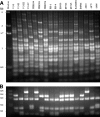Heteroresistance of Cryptococcus gattii to fluconazole
- PMID: 20385871
- PMCID: PMC2876399
- DOI: 10.1128/AAC.00153-10
Heteroresistance of Cryptococcus gattii to fluconazole
Abstract
We analyzed 71 clinical and environmental Cryptococcus gattii strains that had been isolated before or after the advent of azole antifungals to determine their level of heteroresistance to fluconazole (LHF). All strains of C. gattii manifested heteroresistance, with LHFs that ranged between 4 microg/ml and 32 microg/ml. A considerably higher proportion of the C. gattii strains (86%) than Cryptococcus neoformans strains (46%) exhibited LHFs that were > or =16 microg/ml. No significant correlation was observed between the molecular type or serotypes of strains and their respective LHF. The strains which expressed a higher LHF were also more resistant to xenobiotics than the strains with a low LHF, and the level of resistance to xenobiotics was significantly higher than that reported for C. neoformans. The heteroresistant subpopulation, whose level of drug resistance had been raised in a stepwise manner to 64 microg/ml, reverted to the original LHF upon daily transfers in drug-free medium. Importantly, the strains with high LHFs were significantly more virulent than those with low LHFs. Since all the clinical isolates that had not been exposed to azole drugs as well as the environmental strains manifested heteroresistance to fluconazole, heteroresistance of C. gattii to azoles is an intrinsic mechanism as in C. neoformans and is associated with the strain's virulence.
Figures






Similar articles
-
Investigation of fluconazole heteroresistance in clinical and environmental isolates of Cryptococcus neoformans complex and Cryptococcus gattii complex in the state of Amazonas, Brazil.Med Mycol. 2022 Mar 3;60(3):myac005. doi: 10.1093/mmy/myac005. Med Mycol. 2022. PMID: 35084497
-
Heteroresistance to fluconazole in Cryptococcus neoformans is intrinsic and associated with virulence.Antimicrob Agents Chemother. 2009 Jul;53(7):2804-15. doi: 10.1128/AAC.00295-09. Epub 2009 May 4. Antimicrob Agents Chemother. 2009. PMID: 19414582 Free PMC article.
-
Antifungal susceptibility of clinical and environmental Cryptococcus neoformans and Cryptococcus gattii isolates in Jabalpur, a city of Madhya Pradesh in Central India.Braz J Microbiol. 2015 Oct-Dec;46(4):1125-33. doi: 10.1590/S1517-838246420140564. Epub 2015 Oct 27. Braz J Microbiol. 2015. PMID: 26691471 Free PMC article.
-
Antifungal Resistance in Cryptococcal Infections.Pathogens. 2024 Jan 29;13(2):128. doi: 10.3390/pathogens13020128. Pathogens. 2024. PMID: 38392866 Free PMC article. Review.
-
Environmental prevalence of Cryptococcus neoformans and Cryptococcus gattii in India: an update.Crit Rev Microbiol. 2012 Feb;38(1):1-16. doi: 10.3109/1040841X.2011.606426. Epub 2011 Dec 1. Crit Rev Microbiol. 2012. PMID: 22133016 Review.
Cited by
-
Associations between Cryptococcus Genotypes, Phenotypes, and Clinical Parameters of Human Disease: A Review.J Fungi (Basel). 2021 Mar 30;7(4):260. doi: 10.3390/jof7040260. J Fungi (Basel). 2021. PMID: 33808500 Free PMC article. Review.
-
Aspergillus fumigatus Can Display Persistence to the Fungicidal Drug Voriconazole.Microbiol Spectr. 2023 Mar 13;11(2):e0477022. doi: 10.1128/spectrum.04770-22. Online ahead of print. Microbiol Spectr. 2023. PMID: 36912663 Free PMC article.
-
Synthesis and antifungal activity in vitro of isoniazid derivatives against histoplasma capsulatum var. capsulatum.Antimicrob Agents Chemother. 2014 May;58(5):2504-11. doi: 10.1128/AAC.01654-13. Epub 2014 Feb 10. Antimicrob Agents Chemother. 2014. PMID: 24514090 Free PMC article.
-
Control of Cryptococcus Gattii Biofilms by an Ethanolic Extract of Cochlospermum Regium (Schrank) Pilger Leaves.ScientificWorldJournal. 2018 Jun 6;2018:5764187. doi: 10.1155/2018/5764187. eCollection 2018. ScientificWorldJournal. 2018. PMID: 29977170 Free PMC article.
-
A low-affinity penicillin-binding protein 2x variant is required for heteroresistance in Streptococcus pneumoniae.Antimicrob Agents Chemother. 2014 Jul;58(7):3934-41. doi: 10.1128/AAC.02547-14. Epub 2014 Apr 28. Antimicrob Agents Chemother. 2014. PMID: 24777105 Free PMC article.
References
-
- Armengou, A., C. Porcar, J. Mascaro, and F. Garcia-Bragado. 1996. Possible development of resistance to fluconazole during suppressive therapy for AIDS-associated cryptococcal meningitis. Clin. Infect. Dis. 23:1337-1338. - PubMed
-
- Berg, J., C. J. Clancy, and M. H. Nguyen. 1998. The hidden danger of primary fluconazole prophylaxis for patients with AIDS. Clin. Infect. Dis. 26:186-187. - PubMed
-
- Birley, H. D., E. M. Johnson, P. McDonald, C. Parry, P. B. Carey, and D. W. Warnock. 1995. Azole drug resistance as a cause of clinical relapse in AIDS patients with cryptococcal meningitis. Int. J. STD AIDS 6:353-355. - PubMed
-
- Boekhout, T., B. Theelen, M. Diaz, J. W. Fell, W. C. Hop, E. C. Abeln, F. Dromer, and W. Meyer. 2001. Hybrid genotypes in the pathogenic yeast Cryptococcus neoformans. Microbiology 147:891-907. - PubMed
Publication types
MeSH terms
Substances
Grants and funding
LinkOut - more resources
Full Text Sources

